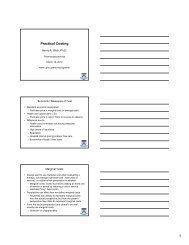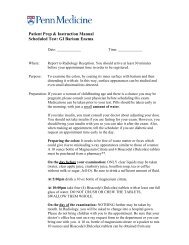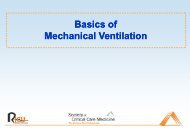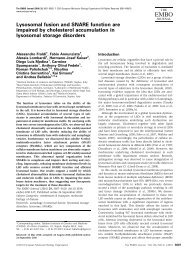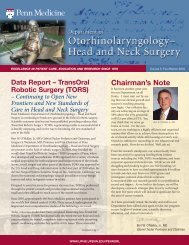Essentials of water treatment in hemodialysis - Penn Medicine
Essentials of water treatment in hemodialysis - Penn Medicine
Essentials of water treatment in hemodialysis - Penn Medicine
You also want an ePaper? Increase the reach of your titles
YUMPU automatically turns print PDFs into web optimized ePapers that Google loves.
Hemodialysis International 2005; 9: 127–134<br />
Core Curriculum<br />
<strong>Essentials</strong> <strong>of</strong> <strong>water</strong> <strong>treatment</strong> <strong>in</strong><br />
<strong>hemodialysis</strong><br />
Suhail AHMAD<br />
Dialysis/Apheresis, University <strong>of</strong> Wash<strong>in</strong>gton, Scribner Kidney Center, Northwest Kidney Center, Seattle,<br />
Wash<strong>in</strong>gton, U.S.A.<br />
INTRODUCTION<br />
Water purity for dialysis is <strong>of</strong> critical importance for patient<br />
health and outcome, and <strong>in</strong> this regard there are three major<br />
po<strong>in</strong>ts to consider: 1) Hemodialysis (HD) patients are<br />
exposed to more than 400 L <strong>of</strong> <strong>water</strong> per week. Contrast<br />
this with a person with normal kidney dr<strong>in</strong>k<strong>in</strong>g only less<br />
than 15 L <strong>of</strong> <strong>water</strong> per week. 2) The stomach acid and<br />
<strong>in</strong>test<strong>in</strong>al barrier protect from the ills <strong>of</strong> contam<strong>in</strong>ated<br />
<strong>water</strong> more effectively than the barrier imposed by the<br />
dialyzer membrane. 3) The function<strong>in</strong>g kidney can further<br />
protect the normal <strong>in</strong>dividual from the contam<strong>in</strong>ants <strong>of</strong><br />
<strong>water</strong> by elim<strong>in</strong>at<strong>in</strong>g these, this protection be<strong>in</strong>g absent for<br />
the HD patient. Thus the regulations govern<strong>in</strong>g the purity <strong>of</strong><br />
dr<strong>in</strong>k<strong>in</strong>g <strong>water</strong> are further modified by the above considerations:<br />
exposure <strong>of</strong> only 10 to 15 L per week and the efficacy<br />
<strong>of</strong> gut and kidney to protect the <strong>in</strong>dividual. Whereas the<br />
dialysis <strong>water</strong> is regulated by more strict purity guidel<strong>in</strong>es,<br />
failure <strong>in</strong> observ<strong>in</strong>g any <strong>of</strong> these guidel<strong>in</strong>es has had disastrous<br />
consequences. The use <strong>of</strong> modern more permeable<br />
dialyzer membranes has <strong>in</strong>creased the risk <strong>of</strong> <strong>water</strong> contam<strong>in</strong>ation,<br />
and more str<strong>in</strong>gent purity standards must be strictly<br />
followed to avoid harm to the patient.<br />
To make <strong>water</strong> healthier and relatively pure, <strong>water</strong><br />
authorities <strong>of</strong>ten add chemicals such as fluoride, alum<strong>in</strong>um,<br />
chlor<strong>in</strong>e, and chloram<strong>in</strong>es. This makes <strong>water</strong> unsafe<br />
for HD use, because these chemicals have been known to<br />
accumulate <strong>in</strong> dialysis patients lead<strong>in</strong>g to significant morbidity<br />
and mortality. Thus, alum<strong>in</strong>um <strong>in</strong> the dialysis<br />
Correspondence to: Suhail Ahmad, MD, Associate<br />
Pr<strong>of</strong>essor, Medic<strong>in</strong>e, Medical Director, Dialysis/Apheresis,<br />
University <strong>of</strong> Wash<strong>in</strong>gton, Medical Director, Scribner<br />
Kidney Center, Northwest Kidney Center, Seattle, WA<br />
98133 U.S.A.<br />
E-mail: sahmad@u.wash<strong>in</strong>gton.edu<br />
<strong>water</strong> has caused severe alum<strong>in</strong>um <strong>in</strong>toxications <strong>of</strong>ten<br />
lead<strong>in</strong>g to death. Similarly fluoride <strong>in</strong>toxication has also<br />
led to significant cl<strong>in</strong>ical catastrophes. Chemicals leach<strong>in</strong>g<br />
from <strong>water</strong> pipes have also led to chemical <strong>in</strong>toxications;<br />
thus, pipes made <strong>of</strong> lead, copper, or brass z<strong>in</strong>c are<br />
not suitable for deliver<strong>in</strong>g <strong>water</strong> for dialysis.<br />
WATER CONTAMINANTS<br />
The contam<strong>in</strong>ants can be divided <strong>in</strong>to three major categories:<br />
1) particulate matter, 2) chemicals, and 3) microorganisms<br />
and endotox<strong>in</strong>s.<br />
1 Particulate matter (Figure 1, P ): These cause turbidity<br />
and <strong>in</strong>clude clay, iron, sand, chalk, silica, etc.<br />
2 Chemicals: These <strong>in</strong>clude dissolved <strong>in</strong>organic ions and<br />
salts (Figure 1, I ) such as Na, Cl, Al, Ca, Mg, and Fl.<br />
Organic matter <strong>in</strong>cludes (Figure 1, O ) <strong>in</strong>dustrial and agricultural<br />
tox<strong>in</strong>s such as fertilizers, pesticides, and oils.<br />
3 Microorganisms (Figure 1, M ) and endotox<strong>in</strong>s (Figure 1,<br />
E ): These <strong>in</strong>clude predom<strong>in</strong>antly bacteria and occasionally<br />
fungi, viruses, protozoa, spores, and endotox<strong>in</strong>s<br />
produced by the organisms.<br />
DEVICES TO CLEAN WATER<br />
Figure 1 shows various methods <strong>of</strong> clean<strong>in</strong>g <strong>water</strong> and the<br />
quality <strong>of</strong> product <strong>water</strong> from these devices. The most<br />
effective method, distillation, is not used for dialysis<br />
<strong>water</strong> for two major reasons: it requires large amounts<br />
<strong>of</strong> energy and the yield is relatively small compared to the<br />
rate <strong>of</strong> required <strong>water</strong> consumption.<br />
Table 1 summarizes the advantages and disadvantages<br />
<strong>of</strong> all the purification methods. It is clear that not any<br />
s<strong>in</strong>gle method purifies <strong>water</strong> completely, and a comb<strong>in</strong>ation<br />
ª 2005 International Society for Hemodialysis 127
Ahmad<br />
<strong>of</strong> several devices is needed to produce <strong>water</strong> that can be<br />
used for dialysis.<br />
TYPICAL WATER TREATMENT SYSTEM<br />
The design <strong>of</strong> a <strong>water</strong> <strong>treatment</strong> system is dependent on<br />
the quality <strong>of</strong> feed <strong>water</strong> and local requirements <strong>of</strong> the<br />
purity standards. One typical scheme commonly used is<br />
shown <strong>in</strong> Figure 2; this system will be first discussed and<br />
then common variations would be further elaborated.<br />
BACKFLOW-PREVENTING DEVICE (BFD)<br />
The feed <strong>in</strong> <strong>water</strong> first comes <strong>in</strong> the unit and goes through<br />
a backflow-prevent<strong>in</strong>g device; this is essentially a valve<br />
that prevents the dialysis unit <strong>water</strong> flow<strong>in</strong>g back <strong>in</strong>to the<br />
city/build<strong>in</strong>g supply <strong>water</strong>. Often this device is supported<br />
by an additional booster pump that helps ma<strong>in</strong>ta<strong>in</strong> the<br />
necessary m<strong>in</strong>imum pressure despite fluctuat<strong>in</strong>g pressure<br />
and flow from the feed l<strong>in</strong>e.<br />
TEMPERATURE-BLENDING VALVE (TBV)<br />
The reverse osmosis (RO) unit works most efficiently if<br />
feed <strong>water</strong> temperature is 77 F. A heater and blend<strong>in</strong>g<br />
valve assures a constant desired temperature by blend<strong>in</strong>g<br />
heated <strong>water</strong> with cold <strong>water</strong>. This unit is sometimes<br />
placed right at the beg<strong>in</strong>n<strong>in</strong>g <strong>of</strong> the <strong>water</strong> system and<br />
sometimes more distally.<br />
FILTERS<br />
Table 1 Comparison <strong>of</strong> advantages and disadvantages <strong>of</strong> various <strong>water</strong> purification devices<br />
A series <strong>of</strong> <strong>in</strong>creas<strong>in</strong>gly tighter filters (with smaller pores)<br />
are placed <strong>in</strong> the <strong>water</strong> l<strong>in</strong>e. In Figure 2, these are shown<br />
Benefits Limitations<br />
1. S<strong>of</strong>teners<br />
Effectively removes Ca, Mg (hardness) Ineffective at remov<strong>in</strong>g other contam<strong>in</strong>ants<br />
Inexpensive Difficult to sanitize<br />
Easy to regenerate Needs frequent regeneration<br />
Res<strong>in</strong> exhaustion leads to hard <strong>water</strong><br />
Promotes bacterial growth<br />
2. Activated carbon<br />
Effective at remov<strong>in</strong>g organic contam<strong>in</strong>ants,<br />
Exhaustable adsorptive capacity, risk <strong>of</strong> spillover<br />
chlor<strong>in</strong>e, and chloram<strong>in</strong>e<br />
I<br />
O<br />
City Water<br />
Feed Water<br />
E M E M<br />
O P I O P I<br />
Product Water<br />
Ultrafiltration<br />
(1000 Da)<br />
M<br />
P<br />
E<br />
O<br />
M O O<br />
E<br />
I<br />
E M E M<br />
O P I O P I<br />
Deionizer Reverse<br />
Osmosis<br />
Distillation<br />
Figure 1 Commonly used <strong>water</strong> purification devices. P ¼<br />
particulate matter; I ¼ <strong>in</strong>organic ions and salts; O ¼ organic<br />
matter; M ¼ microorganisms; E ¼ endotox<strong>in</strong>s.<br />
Inexpensive Promotes bacterial growth<br />
Difficult to sanitize<br />
Releases ‘‘f<strong>in</strong>es’’ (abrasive particles)<br />
3. DI<br />
Effective at remov<strong>in</strong>g ions Ineffective at remov<strong>in</strong>g organics and microorganism<br />
Low ma<strong>in</strong>tenance cost Facilitates bacterial growth<br />
Easy to regenerate Release <strong>of</strong> particles<br />
Risk <strong>of</strong> spillover with exhaustion <strong>of</strong> res<strong>in</strong>s<br />
4. RO<br />
Removes almost all dissolved ions Needs pre<strong>treatment</strong><br />
Removes almost all organisms and fragments Uses large quantities <strong>of</strong> <strong>water</strong><br />
Life <strong>of</strong> membrane depends on quality <strong>of</strong> <strong>water</strong><br />
128 Hemodialysis International 2005; 9: 127–134
City<br />
Water<br />
BFD<br />
TBV<br />
5 µm<br />
F-1<br />
Carbon<br />
1.0 0.45<br />
µm µm<br />
as F-1 through F-4 with the filter size listed <strong>in</strong> micrometers.<br />
The very first, F-1, is basically to remove large<br />
particulate matter from the feed <strong>water</strong> and <strong>of</strong>ten this<br />
<strong>in</strong>cludes mud with large silica and clay particles.<br />
ACTIVATED CARBON FILTERS (TANK/<br />
COLUMN)<br />
Granules <strong>of</strong> activated carbon are packed <strong>in</strong> a cartridge<br />
and <strong>water</strong> is allowed to flow around these granules. The<br />
microporous structure <strong>of</strong> the carbon permits adsorption<br />
<strong>of</strong> organic matter and chlor<strong>in</strong>e and chloram<strong>in</strong>es over its<br />
large surface area relative to weight. Activated carbon<br />
columns are not effective filters. The carbon columns<br />
tend to release ‘‘f<strong>in</strong>es,’’ which are abrasive particles. A<br />
series <strong>of</strong> micr<strong>of</strong>ilters (F-2, F-3) are <strong>in</strong>serted after the<br />
carbon column to remove these f<strong>in</strong>es. Often there are<br />
two activated carbon tanks <strong>in</strong> series: the first is called<br />
the primary and second the polisher carbon tank (not<br />
shown <strong>in</strong> Figure 2). Two very important issues related to<br />
carbon filters are the exhaustion <strong>of</strong> the carbon and the<br />
growth <strong>of</strong> microbial organisms. The exhaustion <strong>of</strong> the<br />
adsorptive capacity leads to <strong>in</strong>creased concentrations <strong>of</strong><br />
chlor<strong>in</strong>e, chloram<strong>in</strong>es, and organic matter <strong>in</strong> the postcarbon<br />
<strong>water</strong>. To prevent this, the postcarbon <strong>water</strong> should<br />
be monitored for chlor<strong>in</strong>e and chloram<strong>in</strong>es, and its presence<br />
<strong>in</strong> concentrations beyond the acceptable range<br />
(Table 2) should lead to the change <strong>of</strong> carbon filter. The<br />
carbon columns are a major source <strong>of</strong> bacterial and endo-<br />
F-2<br />
F-3<br />
S<strong>of</strong>tener<br />
Dialysis Stations<br />
0.22 µm<br />
Figure 2 One <strong>of</strong> the commonly used schemes <strong>of</strong> <strong>water</strong> <strong>treatment</strong>. (For abbreviation, see text.)<br />
F-4<br />
Dra<strong>in</strong><br />
<strong>Essentials</strong> <strong>of</strong> <strong>water</strong> <strong>treatment</strong> <strong>in</strong> <strong>hemodialysis</strong><br />
tox<strong>in</strong> contam<strong>in</strong>ation because the porous surface, the presence<br />
<strong>of</strong> organic matter, and the removal <strong>of</strong> chlor<strong>in</strong>e all<br />
favor microbial growth. Monitor<strong>in</strong>g <strong>of</strong> the carbon filter<br />
and periodic flush<strong>in</strong>g with chlor<strong>in</strong>e keeps the microorganism<br />
growth under control.<br />
WATER SOFTENER<br />
RO<br />
To protect the downstream <strong>water</strong> <strong>treatment</strong> device <strong>of</strong><br />
choice, reverse osmosis (RO) or deionizer (DI), large<br />
concentrations <strong>of</strong> divalent cations must be removed<br />
from the <strong>water</strong>. The high concentrations <strong>of</strong> Ca and Mg<br />
<strong>in</strong> the city <strong>water</strong> cause hardness and limit the life <strong>of</strong> DI or<br />
RO devices. Water s<strong>of</strong>teners use res<strong>in</strong> beads fixed with<br />
Na. As <strong>water</strong> is allowed to pass around these fixed-bead<br />
cations <strong>in</strong> <strong>water</strong> (Ca, Mg, iron and manganese) are<br />
exchanged with Na, thus mak<strong>in</strong>g the product <strong>water</strong> s<strong>of</strong>ter<br />
with
Ahmad<br />
Table 2 Contam<strong>in</strong>ants <strong>in</strong> <strong>water</strong> and their toxic effects and maximum allowable concentrations<br />
Maximum<br />
Contam<strong>in</strong>ant Toxic effect concentration (mg/L)<br />
Alum<strong>in</strong>um<br />
Known to be toxic to dialysis patients<br />
Encephalopathy, bone disease, anemia < 0.01<br />
Chloram<strong>in</strong>es Hemolysis, anemia, methemoglob<strong>in</strong>emia < 0.10<br />
Chlor<strong>in</strong>e 0.5<br />
Copper Hemolysis, fever, headache, hepatitis < 0.10<br />
Fluoride Bone disease, osteomalacia < 0.20<br />
Nitrate Cyanosis, methemoglob<strong>in</strong>emia, hypotension, nausea < 2.0<br />
Sulfate Nausea, vomit<strong>in</strong>g, acidosis 100<br />
Z<strong>in</strong>c Anemia, nausea, vomit<strong>in</strong>g, fever<br />
Normally present <strong>in</strong> dialysate<br />
0.1<br />
Calcium Nausea, vomit<strong>in</strong>g, weakness, headache, hypertension, malaise, cardiac problems < 2 (0.1 mEq/L)<br />
Magnesium Nausea, vomit<strong>in</strong>g, weakness, headache, hypertension, malaise, cardiac problems < 4.0 (0.3 mEq/L)<br />
Potassium Muscle symptoms, bradyrrhythmia, death 8 (0.2 mEq/L)<br />
Sodium Hypertension, pulmonary edema, headache, thirst, confusion, seizure, coma<br />
Unsafe even <strong>in</strong> dr<strong>in</strong>k<strong>in</strong>g <strong>water</strong><br />
70 (3.0 mEq/L)<br />
Arsenic Nausea, vomit<strong>in</strong>g, diarrhea, hepatitis, polyneuropathy, sk<strong>in</strong> lesions 0.005<br />
Barium Hypokalemia 0.1<br />
Beryllium Pulmonary granulomatous disease with cough, weight loss 0.0004<br />
Cadmium Bone disease, renal disease 0.001<br />
Chromium Carc<strong>in</strong>ogen 0.014<br />
Lead Abdom<strong>in</strong>al pa<strong>in</strong>, neuropathy, nephropathy, encephalopathy, hypertension 0.005<br />
Mercury Tremors, g<strong>in</strong>givitis, psychiatric symptoms 0.0002<br />
Selenium Nausea, vomit<strong>in</strong>g, diarrhea 0.09<br />
Silver Vomit<strong>in</strong>g, diarrhea, shock, coma, convulsions, death 0.005<br />
Thallium Neuropathy 0.002<br />
RO or mixed-bed DI. The advantages and disadvantages<br />
<strong>of</strong> these two devices are listed <strong>in</strong> the Table 1. Some<br />
units use both devices, either <strong>in</strong> a series, less commonly,<br />
or more commonly, a DI as a back up for the reverse<br />
osmosis.<br />
Feed Water<br />
Ca & Mg Na<br />
Hard<br />
Figure 3 Water s<strong>of</strong>tener.<br />
Product Water<br />
S<strong>of</strong>t<br />
Na<br />
Water Conta<strong>in</strong><strong>in</strong>g<br />
Ca & Mg<br />
Na<br />
Ca Mg<br />
Res<strong>in</strong> Beads with Na<br />
Ca & Mg Exchanged with Na<br />
Product Water with Na<br />
(Ca Mg Removed)<br />
RO SYSTEM<br />
RO is the most cost-effective method for <strong>water</strong> purification<br />
from both organic and <strong>in</strong>organic solutes, <strong>in</strong>clud<strong>in</strong>g<br />
organisms and endotox<strong>in</strong>s. This is a filtration process <strong>of</strong><br />
<strong>water</strong> across a very tight membrane with ionic rejection <strong>of</strong><br />
90% to 99%. When <strong>water</strong> is filtered across this tight<br />
membrane, the filtered <strong>water</strong> is called ‘‘permeate’’ or<br />
‘‘RO <strong>water</strong>’’ and <strong>water</strong> conta<strong>in</strong><strong>in</strong>g rejected solutes and<br />
other substances is called ‘‘rejection,’’ ‘‘concentrate,’’ or<br />
‘‘br<strong>in</strong>e.’’ The osmolarity <strong>of</strong> br<strong>in</strong>e (conta<strong>in</strong><strong>in</strong>g solutes) is a<br />
lot higher than the osmolarity <strong>of</strong> permeate; normally the<br />
<strong>water</strong> would move from permeate to br<strong>in</strong>e because <strong>of</strong><br />
higher osmotic pressure. Enough mechanical force<br />
(hydraulic pressure) with a pump, however, is applied<br />
on the br<strong>in</strong>e side; <strong>water</strong> is thus forced (filtered) aga<strong>in</strong>st<br />
the osmolar force across the membrane. RO membranes<br />
are like dialyzer membranes except the pores are so small<br />
that they do not even allow any solute <strong>in</strong>clud<strong>in</strong>g Na or<br />
other ions and any organic matter (Figure 4). Three<br />
different types <strong>of</strong> membranes, cellulosic, synthetic, and<br />
th<strong>in</strong> composite membranes, similar to dialyzers, are fitted<br />
130 Hemodialysis International 2005; 9: 127–134
RO Water<br />
(Permeate)<br />
Figure 4 RO cyl<strong>in</strong>der.<br />
<strong>in</strong> different designs, parallel plates, hollow fibers, or<br />
spiral wounds.<br />
Chlor<strong>in</strong>e, chloram<strong>in</strong>es, the pH <strong>of</strong> <strong>water</strong>, dis<strong>in</strong>fectants,<br />
and bacteria all potentially destroy the membrane. Chemicals<br />
are more harmful to synthetic membranes and bacteria<br />
to cellulosic membranes, and generally composite membranes<br />
are more resistant. The performance <strong>of</strong> the RO<br />
membrane must be monitored by measur<strong>in</strong>g the resistivity<br />
<strong>of</strong> the RO <strong>water</strong>. Pure <strong>water</strong> is highly resistant to an electrical<br />
current; this electrical conductivity <strong>in</strong>creases if more<br />
ions are present. The acceptable production to rejection<br />
ratio is >0.85; a value below 0.80 means that the membrane<br />
must be changed. The rejection ratio is calculated<br />
from conductivity <strong>in</strong> the feed <strong>water</strong> and the product (RO)<br />
<strong>water</strong>, by us<strong>in</strong>g the formula, 1 – (RO <strong>water</strong> conductivity/<br />
feed <strong>water</strong> conductivity) 100. Conductivity is dependent<br />
on total dissolved solutes <strong>in</strong> parts per million (ppm).<br />
For example,<br />
Conductivity feed <strong>water</strong> ¼ 100 ppm<br />
Conductivity RO <strong>water</strong> ¼ 8 ppm<br />
Rejection ratio ¼f1 ð8=100Þg 100 :<br />
¼ð1 0:08Þ 100<br />
¼ 92 %:<br />
If after 6 months the feed <strong>water</strong> conductivity is<br />
unchanged but the RO <strong>water</strong> conductivity <strong>in</strong>creases to<br />
20, this means that the rejection ratio is only 80% and it is<br />
time to change the membrane.<br />
DI<br />
Rejection<br />
(Br<strong>in</strong>e)<br />
Feed Water (s<strong>of</strong>t)<br />
R/O Membrane<br />
RO Water<br />
(Permeate)<br />
This process removes <strong>in</strong>organic ions dissolved <strong>in</strong> the<br />
<strong>water</strong> by an ion-exchange process us<strong>in</strong>g cationic and<br />
anionic res<strong>in</strong>s. When <strong>water</strong> is passed through the DI<br />
first, the cationic res<strong>in</strong> exchanges dissolved cations<br />
Na + Cl<br />
H + Cl<br />
Cationic Exchange<br />
Res<strong>in</strong> Exchanges<br />
Dissolved Cations<br />
(Na, Ca etc) With H<br />
Figure 5 Mixed-bed DI.<br />
<strong>Essentials</strong> <strong>of</strong> <strong>water</strong> <strong>treatment</strong> <strong>in</strong> <strong>hemodialysis</strong><br />
H + OH = H 2O<br />
Anionic Exchange<br />
Res<strong>in</strong> Exchanges<br />
Dissolved Anions<br />
(Cl, SO 4 etc) With OH<br />
(Na þ , Ca þ , Al þ , Mg þ , etc.) with H þ ions (Figure 5).<br />
Water conta<strong>in</strong><strong>in</strong>g H þ ions and very little other cations<br />
then percolates around the anionic res<strong>in</strong> where the<br />
dissolved anions are exchanged with OH – ions, and H þ<br />
and OH – ions comb<strong>in</strong>e to form pure <strong>water</strong>, free <strong>of</strong> all<br />
cations and anions. This product <strong>water</strong> has high resistivity<br />
(> 1 MOhm/cm); monitor<strong>in</strong>g <strong>of</strong> resistivity alerts if<br />
res<strong>in</strong> beds are exhausted because the presence <strong>of</strong> <strong>in</strong>organic<br />
ions would decrease the resistivity <strong>of</strong> the <strong>water</strong>. The<br />
res<strong>in</strong>s are regenerated by us<strong>in</strong>g HCl and NaOH or bleach.<br />
DI are very effective <strong>in</strong> remov<strong>in</strong>g <strong>in</strong>organic ions but are<br />
<strong>in</strong>effective <strong>in</strong> remov<strong>in</strong>g organic and other contam<strong>in</strong>ants.<br />
In fact, DI may become a site for bacterial growth and<br />
may lead to downstream contam<strong>in</strong>ation. The DI<br />
described above is a mixed-bed solid-phase DI. The cont<strong>in</strong>uous<br />
electric deionizer (CDI) is the other type <strong>of</strong> DI<br />
recently be<strong>in</strong>g used that utilizes electric current and ionexchange<br />
membranes and res<strong>in</strong>s to remove ions from<br />
<strong>water</strong>. CDI produces very high quality <strong>water</strong> with resistivity<br />
as high as 20 MOhm/cm. This type <strong>of</strong> DI also has<br />
less bacterial growth because <strong>of</strong> cont<strong>in</strong>uous <strong>water</strong> flux.<br />
ULTRAVIOLET (UV) TREATMENT<br />
UV radiation is an effective way to kill all types <strong>of</strong> bacteria<br />
<strong>in</strong> all states. Its efficacy, however, depends on the depth<br />
<strong>of</strong> penetration and <strong>water</strong> flow rates. Germicidal UV lamps<br />
are commercially available but have a limited life span.<br />
UV is effective but <strong>in</strong>creases lipopolysaccharides and fragments<br />
by bacterial kill<strong>in</strong>g. UV alone is not an effective<br />
<strong>water</strong> <strong>treatment</strong> device and is normally used <strong>in</strong> conjunction<br />
Hemodialysis International 2005; 9: 127–134 131
Ahmad<br />
with DI and should be followed by ultrafiltration to<br />
remove bacterial fragments.<br />
WATER DELIVERY LOOP<br />
Purified <strong>water</strong> is run through the dialysis unit <strong>in</strong> a loop as<br />
shown <strong>in</strong> Figure 2, the term<strong>in</strong>al end <strong>of</strong> the loop end<strong>in</strong>g <strong>in</strong><br />
the pipe feed<strong>in</strong>g <strong>water</strong> <strong>in</strong>to the RO or DI unit. Dialysis<br />
mach<strong>in</strong>es are connected to this loop <strong>in</strong> parallel withdraw<strong>in</strong>g<br />
<strong>water</strong> for proportion<strong>in</strong>g with dialysate concentrate.<br />
The second arrangement is shown <strong>in</strong> Figure 6 where the<br />
purified <strong>water</strong> is delivered <strong>in</strong>to a hold<strong>in</strong>g tank from which<br />
the <strong>water</strong> is pumped <strong>in</strong>to the distribution loop that<br />
returns <strong>water</strong> back <strong>in</strong>to the tank.<br />
MATERIAL FOR PIPE AND FITTINGS<br />
Substances for <strong>water</strong> pipes and surfaces exposed to <strong>water</strong><br />
can leach <strong>in</strong> the <strong>water</strong> and have been known to cause<br />
toxicity <strong>in</strong> dialysis patients. For example, copper <strong>in</strong>toxication<br />
from copper pipes and the accumulation <strong>of</strong> alum<strong>in</strong>um<br />
dissolved <strong>in</strong> <strong>water</strong> has happened. It is therefore<br />
required, that all the <strong>water</strong> pipes <strong>in</strong> dialysis units should<br />
be free <strong>of</strong> metals and are constructed <strong>of</strong> polyv<strong>in</strong>ylchloride.<br />
Similarly, all the surfaces exposed to <strong>water</strong> such as<br />
storage tank or cas<strong>in</strong>gs <strong>of</strong> the devices should be constructed<br />
<strong>of</strong> materials that do not readily leach <strong>in</strong> the<br />
<strong>water</strong>.<br />
Dra<strong>in</strong><br />
R/O<br />
Dialysis Stations<br />
0.1-µm<br />
filter<br />
Storage<br />
Tank<br />
Pump<br />
0.1-µm<br />
filter<br />
Figure 6 Water loop connected to a storage tank.<br />
WATER QUALITY STANDARDS<br />
Even <strong>in</strong> the early days <strong>of</strong> dialysis it was known that s<strong>of</strong>t<br />
<strong>water</strong> should be used to avoid problems with excess Ca<br />
and Mg, the ‘‘hard <strong>water</strong> syndrome.’’ With time, the<br />
cl<strong>in</strong>ical syndromes associated with accumulations <strong>of</strong> various<br />
ions com<strong>in</strong>g from the <strong>water</strong> gradually forced tighter<br />
purity standards. Most dramatic and damag<strong>in</strong>g was the<br />
alum<strong>in</strong>um <strong>in</strong>toxications caus<strong>in</strong>g severe morbidity and<br />
even mortality. As we learn more about the harmful<br />
effects <strong>of</strong> less pure <strong>water</strong>, particularly with the use <strong>of</strong><br />
very permeable dialyzers, the purity standards are becom<strong>in</strong>g<br />
more str<strong>in</strong>gent. At present, the <strong>water</strong> purity standards<br />
can be divided <strong>in</strong> three broad categories:<br />
1 Standards for <strong>in</strong>organic solutes;<br />
2 Standards for microorganisms and other organics; and<br />
3 Standards for lipopolysaccharide and endotox<strong>in</strong>s.<br />
Standards for <strong>in</strong>organic solutes<br />
Table 2 describes the cl<strong>in</strong>ical effects <strong>of</strong> accumulation <strong>of</strong><br />
various <strong>in</strong>organic substances and the acceptable maximum<br />
concentrations <strong>in</strong> dialysis <strong>water</strong> (as recommended<br />
by Advancement <strong>of</strong> Medical Instrumentation [AAMI]).<br />
Evolution <strong>of</strong> knowledge about <strong>water</strong>-related cl<strong>in</strong>ical problems<br />
is quite <strong>in</strong>terest<strong>in</strong>g and <strong>of</strong>ten based on anecdotal<br />
experiences. Some <strong>of</strong> the important cl<strong>in</strong>ical issues would<br />
be discussed <strong>in</strong> the follow<strong>in</strong>g examples.<br />
Alum<strong>in</strong>um <strong>in</strong>toxication<br />
Outbreaks <strong>of</strong> unexpla<strong>in</strong>ed, progressive dementia <strong>of</strong>ten<br />
lead<strong>in</strong>g to death occurred <strong>in</strong> areas with significant alum<strong>in</strong>um<br />
contam<strong>in</strong>ation <strong>of</strong> local <strong>water</strong> supply. Also noted was<br />
the higher prevalence <strong>in</strong> units not us<strong>in</strong>g adequate <strong>water</strong><br />
purification systems. One <strong>of</strong> the most <strong>in</strong>terest<strong>in</strong>g <strong>in</strong>cidences<br />
occurred <strong>in</strong> Portugal <strong>in</strong> 1993, when city <strong>water</strong><br />
authorities decided to add alum<strong>in</strong>um sulfate as flocculent<br />
to remove particulate matters from the <strong>water</strong>. This subsequently<br />
led to HD patients develop<strong>in</strong>g dementia, and<br />
many deaths occurred. Subsequently, it was discovered<br />
that encephalopathy was caused by alum<strong>in</strong>um <strong>in</strong>toxication<br />
with blood levels as high as 500 mg/L (normal,<br />
Dur<strong>in</strong>g the 1980s dialysis encephalopathy, low-turnover<br />
bone disease, and anemia were common manifestations<br />
<strong>of</strong> alum<strong>in</strong>um <strong>in</strong>toxication. Only a few years ago, on<br />
an island <strong>in</strong> the Netherlands Antilles, 15 patients died <strong>of</strong><br />
alum<strong>in</strong>um <strong>in</strong>toxication caused by the contam<strong>in</strong>ated<br />
cement that was used to patch up <strong>water</strong> pipes. Similarly,<br />
endemics <strong>of</strong> alum<strong>in</strong>um problems have been noticed after<br />
volcanic ashes conta<strong>in</strong><strong>in</strong>g alum<strong>in</strong>um-contam<strong>in</strong>ated <strong>water</strong>.<br />
Chloram<strong>in</strong>e exposure<br />
In 1987, several dozen patients <strong>in</strong> Philadelphia suffered<br />
from nausea, low blood pressure, dyspnea, and anemia.<br />
Eventually the cause was attributed to chloram<strong>in</strong>e exposure.<br />
S<strong>in</strong>ce then, several centers <strong>in</strong> this country and<br />
abroad have experienced problems with chloram<strong>in</strong>es.<br />
Chloram<strong>in</strong>e (comb<strong>in</strong>ation <strong>of</strong> chlor<strong>in</strong>e and ammonia) provides<br />
growth control at a lower cost. Often <strong>water</strong> authorities<br />
add chloram<strong>in</strong>es <strong>in</strong>stead <strong>of</strong> chlor<strong>in</strong>e to control<br />
bacterial growth <strong>in</strong> the city <strong>water</strong>. Unfortunately it is not<br />
removed by either RO or DI. An activated charcoal column<br />
effectively removes it; however, if <strong>water</strong> flow is very<br />
rapid or if the charcoal is exhausted the removal <strong>of</strong><br />
chloram<strong>in</strong>es is <strong>in</strong>effective, lead<strong>in</strong>g to the exposure <strong>of</strong><br />
patients. Several states have mandated that chloram<strong>in</strong>e<br />
levels must be checked <strong>in</strong> the product <strong>water</strong> frequently<br />
(every day to every shift <strong>of</strong> dialysis).<br />
Taken orally chloram<strong>in</strong>e does not cause any cl<strong>in</strong>ical<br />
problems; however, <strong>in</strong> the blood it leads to oxidation <strong>of</strong><br />
hemoglob<strong>in</strong> and destruction <strong>of</strong> red cells by spleen result<strong>in</strong>g<br />
<strong>in</strong> He<strong>in</strong>z body anemia. Acute <strong>in</strong>travascular hemolysis<br />
can be recognized by not<strong>in</strong>g dark blood <strong>in</strong> the blood<br />
l<strong>in</strong>es, shortness <strong>of</strong> breath, palpitation, headache, vomit<strong>in</strong>g,<br />
and severe anemia. Laboratory evidence <strong>of</strong> hemolysis,<br />
He<strong>in</strong>z body anemia, is suggestive and the presence <strong>of</strong><br />
chloram<strong>in</strong>es <strong>in</strong> <strong>water</strong> or dialysate is confirmatory. Other<br />
causes <strong>of</strong> hemolytic anemia <strong>in</strong> this population are exposure<br />
to copper and nitrate (Table 2).<br />
Fluoride exposure<br />
Fluoride is added to city <strong>water</strong> and if not removed can<br />
cause toxicity. Normally the RO and DI remove fluoride.<br />
In contrast, if anion res<strong>in</strong> <strong>in</strong> the mixed-bed DI, which<br />
normally exchanges fluoride with OH ions, gets<br />
exhausted the anion res<strong>in</strong> then can release large quantities<br />
<strong>of</strong> bound fluoride <strong>in</strong> exchange for chloride, sulfate,<br />
and nitrate. This <strong>water</strong> with very high quantities <strong>of</strong> fluoride<br />
can cause severe <strong>in</strong>toxication or death. This happened<br />
<strong>in</strong> Chicago and with<strong>in</strong> 24 hr, three patients died with<br />
arrhythmias. The problem was with the monitor light<br />
which was the same color for safe as for unsafe.<br />
<strong>Essentials</strong> <strong>of</strong> <strong>water</strong> <strong>treatment</strong> <strong>in</strong> <strong>hemodialysis</strong><br />
In the body, fluoride b<strong>in</strong>ds to calcium disrupt<strong>in</strong>g cell<br />
membrane lead<strong>in</strong>g to the leakage <strong>of</strong> potassium and hyperkalemia.<br />
The latter causes cardiac arrhythmia and death.<br />
This hyperkalemia is refractory to the usual management<br />
<strong>in</strong>clud<strong>in</strong>g kayexelate, and the only effective <strong>treatment</strong> is zero<br />
potassium dialysis. The other earlier toxic effects <strong>of</strong> fluoride<br />
<strong>in</strong>clude itch<strong>in</strong>g, pa<strong>in</strong>, gastro<strong>in</strong>test<strong>in</strong>al problems, syncope,<br />
tetany (from hypocalcemia), and neurologic symptoms.<br />
The standards recommended by AAMI for various<br />
<strong>in</strong>organic solutes <strong>in</strong> the <strong>water</strong> and the potential toxic<br />
effects are listed <strong>in</strong> Table 2. It is important that close<br />
vigilance to these standards are constantly ma<strong>in</strong>ta<strong>in</strong>ed to<br />
prevent major catastrophes as exemplified above.<br />
Standards for microorganisms and other<br />
organics<br />
Water and dialysate do not have to be completely free <strong>of</strong><br />
microorganisms because the dialyzer membrane provides an<br />
effective barrier to <strong>in</strong>fectious agents. The AAMI recommends<br />
the maximum acceptable level <strong>of</strong> bacteria to be 200 colonyform<strong>in</strong>g<br />
units (CFU) per milliliter <strong>of</strong> <strong>water</strong>. The recommendation<br />
by the European Pharmacopoeia is 100 CFU/mL.<br />
In 1996, more than 60 dialysis patients died from liver<br />
failure caused by the overgrowth <strong>of</strong> blue/green alga Microcystis<br />
aerog<strong>in</strong>osa <strong>in</strong> the <strong>water</strong> supply <strong>in</strong> Brazil. This alga<br />
produced a cyanotox<strong>in</strong> which is potent hepatic tox<strong>in</strong>. It is<br />
clear that the <strong>water</strong> for the dialysis should be clean, pure,<br />
and free <strong>of</strong> organic contam<strong>in</strong>ants.<br />
Standards for lipopolysaccharide and<br />
endotox<strong>in</strong>s<br />
Endotox<strong>in</strong> levels <strong>in</strong> <strong>water</strong> should be frequently monitored<br />
from different sites to prevent patients gett<strong>in</strong>g exposed to it.<br />
This leads to febrile reactions and may contribute to ongo<strong>in</strong>g<br />
<strong>in</strong>flammation. The endotox<strong>in</strong> is monitored by a LAL test, and<br />
the acceptable level is less than 0.1 EU/mL. Recently, short<br />
DNA fragments have been found <strong>in</strong> the dialysate, capable <strong>of</strong><br />
<strong>in</strong>duc<strong>in</strong>g <strong>in</strong>terleuk<strong>in</strong>-6 and may be responsible for chronic<br />
<strong>in</strong>flammation. 1 Unfortunately, these can pass through the<br />
diayzer membrane and are undetectable by the LAL test.<br />
These oligosaccharides are the fragments <strong>of</strong> bacteria and<br />
more attention may have to be paid to these <strong>in</strong> future.<br />
MONITORING OF WATER SYSTEM<br />
A well-planned monitor<strong>in</strong>g program is the only way to<br />
prevent <strong>water</strong>-related catastrophes <strong>in</strong> the dialysis unit.<br />
Hemodialysis International 2005; 9: 127–134 133
Ahmad<br />
The follow<strong>in</strong>g is a very brief summary <strong>of</strong> some <strong>of</strong> the<br />
major areas <strong>of</strong> monitor<strong>in</strong>g. Each unit must develop a wellorganized<br />
program which is specific for its situation.<br />
Major areas to monitor are:<br />
1) Water s<strong>of</strong>tener:<br />
a. Total hardness <strong>in</strong> the product <strong>water</strong>: The total<br />
<strong>water</strong> hardness should not exceed 1 ppm. This<br />
should be checked once a day, preferably at the end<br />
<strong>of</strong> the day.<br />
b. Pressure drop: If pressure drop changes more<br />
than 10 PSI between pres<strong>of</strong>tener and posts<strong>of</strong>tener<br />
sites, the s<strong>of</strong>tener may need back-flush<strong>in</strong>g.<br />
Most units have an automated setup to back-flush<br />
periodically.<br />
c. Br<strong>in</strong>e tank salt level: Next to the s<strong>of</strong>tener sits a br<strong>in</strong>e<br />
tank that regenerates the s<strong>of</strong>tener periodically. It is<br />
important to make sure that the salt level is ma<strong>in</strong>ta<strong>in</strong>ed<br />
<strong>in</strong> the br<strong>in</strong>e tank. A timer should be <strong>in</strong>stalled<br />
that regenerates the tank while unit is not operat<strong>in</strong>g.<br />
2) Carbon tanks:<br />
a. Chlor<strong>in</strong>e and chloram<strong>in</strong>e levels after the last carbon<br />
tank, preferably each shift.<br />
b. Pressure drop change <strong>of</strong> more than 10 PSI lead<strong>in</strong>g<br />
to back-flush when unit is not operat<strong>in</strong>g.<br />
3) RO<br />
a. Water pressure and flow rates through the unit to<br />
ensure optimum efficiency and life <strong>of</strong> membrane. A<br />
drop <strong>in</strong> <strong>water</strong> flow rate may mean that membrane is<br />
plugg<strong>in</strong>g up.<br />
b. Resistivity and rejection ratio: As discussed above<br />
under the description <strong>of</strong> RO system.<br />
4) DI<br />
a. Water pressure before and after the unit: a change<br />
<strong>of</strong> more than 10 PSI may mean that tanks may be<br />
gett<strong>in</strong>g plugged up.<br />
b. Resistivity and conductivity: See above under the<br />
description <strong>of</strong> DI.<br />
5) Filters: All the filters should be regularly monitored<br />
for pressure drop across the device.<br />
6) Ancillary devices: temperature-blend<strong>in</strong>g valve, backflow<br />
prevention device, booster pump, and acid feed pump<br />
should also be regularly monitored and ma<strong>in</strong>ta<strong>in</strong>ed.<br />
In light <strong>of</strong> our current knowledge it is clear that highly<br />
purified <strong>water</strong> close to the pharmaceutical grade is<br />
needed for use <strong>in</strong> dialysis. For higher-grade <strong>water</strong>, the<br />
term ‘‘ultrapure <strong>water</strong>’’ has been co<strong>in</strong>ed; for chemical<br />
purity, the <strong>water</strong> resistivity should be greater than 5<br />
MOhm/cm rather than the current standard <strong>of</strong> 1<br />
MOhm/cm. More importantly the bacterial and organic<br />
standards would be more str<strong>in</strong>gent. The bacterial count <strong>of</strong><br />







